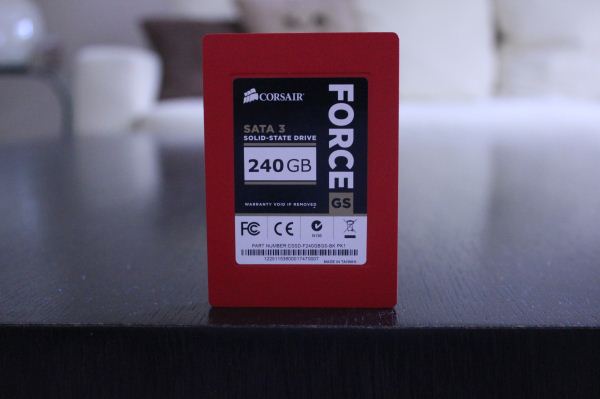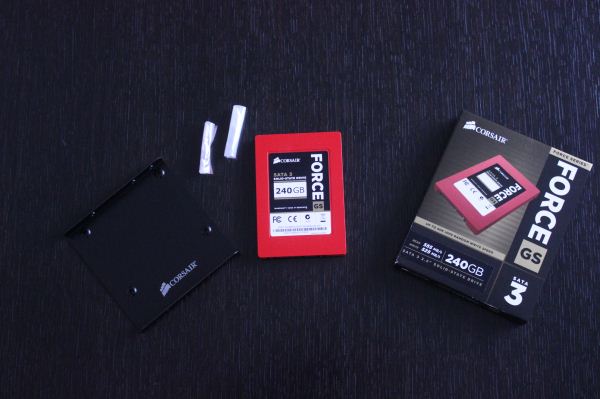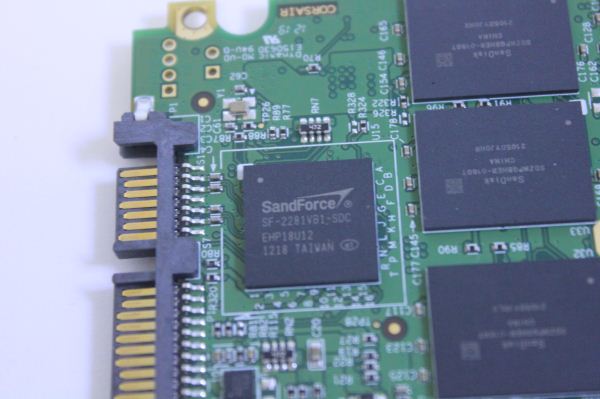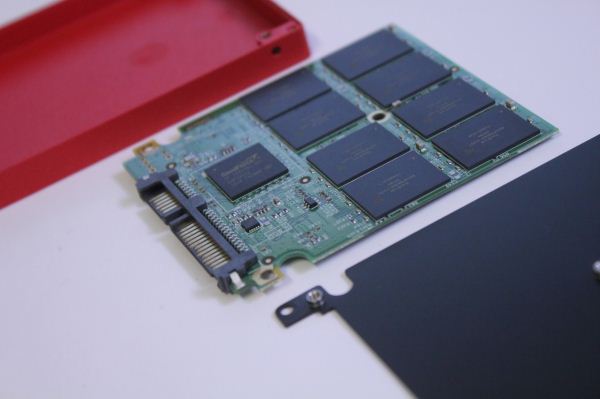SandForce TRIM Issue & Corsair Force Series GS (240GB) Review
by Kristian Vättö on November 22, 2012 1:00 PM ESTInside The Corsair Force GS
Corsair's Force GS uses a similar red plastic chassis as the Force GT.
Included in the retail bundle are two sets of mounting screws and a 2.5" to 3.5" adapter.
The actual PCB is a bit different from what we normally find inside 2.5" SSDs. Its length is only about four fifths of the backplane and it's held in tact by three screws (two in the corners, one in the middle) instead of four. I'm guessing the smaller PCB is slightly cheaper than a regular size 2.5" PCB would have been, hence Corsair opted for one. I don't really see any other explanation because the chassis is still normal size and weight benefit is marginal.
As for the components, there are eight SanDisk's 24nm Toggle-Mode MLC NAND packages on this side of the PCB. These are 16GB packages, meaning that each package consists of two 8GB dies.
Remove the backplane and flip the PCB around and we find another eight NAND packages and SandForce's SF-2281 controller.
Corsair isn't using thermal pads, which isn't all that suprising. Typically thermal pads are only found in high-end SSDs while lower-end models come without in order to offer more competitive pricing.
Test System
| CPU |
Intel Core i5-2500K running at 3.3GHz (Turbo and EIST enabled) |
| Motherboard |
AsRock Z68 Pro3 |
| Chipset |
Intel Z68 |
| Chipset Drivers |
Intel 9.1.1.1015 + Intel RST 10.2 |
| Memory | G.Skill RipjawsX DDR3-1600 2 x 4GB (9-9-9-24) |
| Video Card |
XFX AMD Radeon HD 6850 XXX (800MHz core clock; 4.2GHz GDDR5 effective) |
| Video Drivers | AMD Catalyst 10.1 |
| Desktop Resolution | 1920 x 1080 |
| OS | Windows 7 x64 |
















56 Comments
View All Comments
FunnyTrace - Wednesday, November 28, 2012 - link
Yes, I did read an article on Tweaktown about this in August 2012.JellyRoll - Friday, November 23, 2012 - link
OMG...SandForce does not do dedupe (deduplication). It does not "has to check if the data is used by something else."!!The drive is unaware of the actual file usage above the device level. That is a host level responsibility.
I cannot believe that this article was not vetted before it was posted.
Kristian Vättö - Friday, November 23, 2012 - link
SandForce does deduplication at the device level. It doesn't look for actual files like the host does because it's all ones and zeros for the controller. However, what it does is look for similar data patterns.For example, if you have two very similar photos which are 5MB each, the controller may not write 10MB. Instead, it will only write let's say 8MB to the NAND because some of the data is duplicate and the whole idea of deduplication is to minimize NAND writes.
If you go and delete one of these photos, the OS sends a TRIM command that tells the LBA is no longer in use and it can be deleted. What makes SandForce more complicated is the fact that the photos don't necessarily have their own LBAs, so what you need to do is to check that the LBA you're about to erase is not mapped to any other LBA. Otherwise you might end up erasing a portion of the other photo as well.
JellyRoll - Friday, November 23, 2012 - link
I challenge you to offer one document that supports your assertion that sandforce does deduplication. There ins't any, as it does not. Feel free to link to the technical document to support your claims in your reply.SandForce supports compression, not deduplication.
Here is a link to documentation and product data sheets.
http://www.lsi.com/products/storagecomponents/Page...
Kristian Vättö - Friday, November 23, 2012 - link
SandForce/LSI has published very little about the technology behind DuraWrite and how it works, but a combination of technologies including compression and deduplication is what they have told us.http://www.anandtech.com/show/2899/3
JellyRoll - Friday, November 23, 2012 - link
Linking an Anandtech article is not proof that SandForce does deduplication. A quick Google will reveal that there is no other source, outside of Anandtech, that claims that they offer deduplication on the current series of processors.As a matter of fact, that article is the only other reference to deduplication and SandForce that can be found.
There was a mistake made in that article.
JellyRoll - Friday, November 23, 2012 - link
As a matter of fact, if deduplication were to apply to the SandForce series of processors then incompressible data would also experience decreases in write amplification. SandForce is very public that they have "top follow the same rules" with incompressible data as everyone else. IE, they suffer the same amount of write amplification.Since SandForce controllers only exhibit performance enhancing and endurance increasing benefits from compressible data, that alone indicates that deduplication is not in use.
Deduplication can be applied regardless of the compressibility of the data.
extide - Saturday, November 24, 2012 - link
Incompressible data generally doesnt have duplications in it... that's kinda what makes it incompressible... I mean the whole POINT of compression is removing duplications!JellyRoll - Saturday, November 24, 2012 - link
If you have two matching sets of data, be they incompressible or not, they would be subject to deduplicatioin. It would merely require mapping to the same LBA addresses.For instance, if you have two files that consist of largely incompressible data, but they are still carbon copies of each, they are still subject to data deduplication.
extide - Wednesday, November 28, 2012 - link
That could also be considered compression. Take 2 copies of the same MP3 file and put them into a zip file, how big is the zip file? Pretty close to the size of one copy...